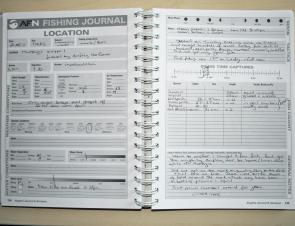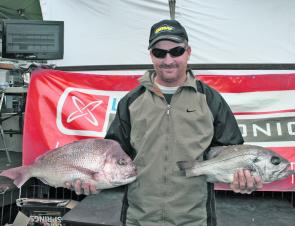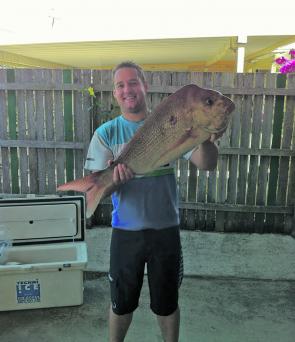For many of you winter seems a lifetime away, but as it does every year it will be upon us before we know it. With winter comes great expectations of large knobbies swallowing a live bait and screaming line racing from our reels. This article will get you thinking about those winter snapper and get you prepared. Hopefully these tips can increase your chance of a big fish and we can all look forward to seeing your toothy grin in the coming issues of the magazine.
There is nothing more important than the quality and freshness of your bait when going for that prize fish. As an angler you will need to know what the fish normally will feed on in your area at certain times of the year. For instance when the best prawns, mullet or squid run is on or when the best time it is to catch live bait. Information like this can be gathered by talking to trawler operators, fisheries officers or experienced anglers. Whatever the bait around the area you are fishing is the bait you need to have on hand.
I have mentioned on many occasions that I have spent more time gathering bait than fishing and it really is a great way to spend time with your mates and family. The other advantage is how much money it will save you over the year. After you have caught your bait then the next step is to package it in small packs and vacuum seal it with a food saver. Don’t fall into the trap of putting heaps of bait in one big bag. If I was freezing squid then I will never put more than 3 individual squid in one vacuum pack. Bait goes off very quickly and it never gets the same attention as the fish in the esky. This is another important point to remember, treat your bait as you do your fish and have plenty of ice on hand and limit the amount you put on the bait board.
If you catch live yakkas, rainbow runners, mullet or slimey mackerel before a trip then make sure you keep the water fresh and oxygenated in the bait tank. Always use a small net to extract the fish from the tank so you will not stress or handle them as much. Presentation is another important issue that we may touch on in coming editions. The old statement that today’s left over bait is tomorrow’s berley is spot on. Never use old bait again and again it will have a dramatic effect on the lack and quality of fish.
As a local it’s important to understand the tides, seasons, currents and moon phases within your fishing area. Snapper have a very distinctive movement pattern and they will normally school in numbers and work around the outer area of a reef or pinnacle. Often the bigger fish can be taken on the gravel areas just before or after a feature and not always right in the middle area. Smaller fish live in the immediate area which attracts bigger fish and so on.
The run up to high tide on dusk or dawn are fantastic times to target quality fish however big fish are consistently taken when the tides occur deep into the night or early morning on the tide change. An angler’s almanac can get you targeting the more productive times to fish. Seasons are also an important element. Anglers should learn what fish are around in any given month of the year so that you can target that species. I recommend keeping a fishing diary and filling out after every trip – it’s very important in establishing patterns. Currents around any area can be seasonal but normally it has a lot to do with the current moon phase.
We always get the highest tides on what moon phase? The strongest currents come when? These are questions you will need to know because all this information will assist you in fishing for the right species in the right depth of water at the best possible time.
Berley is critical when fishing for big fish. A little bit here and there does not cut it and discipline is necessary to make it effective. When the fish are biting their heads off we often concentrate on landing them and getting our bait back in the water and in no time 30 minutes can pass and the berley trail is broken.
Let’s take a step back for one minute and mention that berley should not be old rotten stinking bait. This only attracts the rubbish because you are offering rubbish.
A berley pot can always be the most consistent means to keeping the trail alive. The pot should contain a small mixture of the bait you are going to use and can be topped with chook pellets or fillers and laced with tuna, aniseed or other attractants. Ensure that your berley pot does release a nice slow and steady stream of bait and the best way to do this is to occasionally give it a couple of lifts or jerks to keep the flow. You will need to check the pot and be sure that there is still berley coming out and if you are smart you can time how long it will last and know in advance when it’s time for a top up.
Don’t rely only on your berley pot alone. When you cut up bait there is always a piece that can be chopped up further and thrown out into the deep. This should also be done with some regularity and normally bigger chunks of pilchard or squid should become a part of the berley trail.
I have met very organised anglers and as soon as they return from a trip they are mincing the bait from the trip into a large sausage so that it can be used as berley for the next trip. Berley is a very important part of the whole success story when it comes to catching quality fish.
So if you want to catch bigger fish these three areas are crucial to getting you on the right track. You will also have to put the time in but if you use a diary and make notes of everything you have done then as the years pass you will be way ahead and bringing home the big ones.
Reads: 2725
A fishing diary is a great way to discover snapper behavioural and eating patterns.

Fresh bait and a good berley trail is essential for catching quality table fish.

Snapper are an awesome fighting and wonderful table fish.

The big winter snapper will be here before you know it, so make sure you are prepared.




